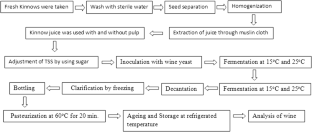Development and characterization of Kinnow wine with and without pulp using activated yeast
Jangra Mukesh R., Verma Chirag, Charaya Garvit, Mangal Manu, Saini Kunal, Jangra Sumit, Nehra K. S.
Research Articles | Published: 06 March, 2019
First Page: 110
Last Page: 115
Views: 3820
Keywords: Kinnow, Wine, Saccharomyces cerevisiae , Physio-chemical, Sensory evaluation
Abstract
We report here the attempts made to prepare and characterize wine from Kinnow. Kinnow is gaining more commercial significance and attractiveness due to its success under varied agro climatic conditions. Its unique characterstics like high fruit yield, fruits quality and wider adaptability make it a very good choice for post harvest processing. Must prepared from Kinnow show very good fermentation when inoculated with sacchromyces cerevisae. Kinnow wines were prepared and evaluated for various physio–chemical characteristics like antioxidant activity, color, ethanol, pH, free and total sulfur dioxide, titrable acidity and enological properties. So, the present investigation was carried to find out the optimal conditions for the efficient conversion of orange juice with or without pulp into wine using Saccharomyces cerevisiae. The optimum process conditions for this fermentation process were 21°, 22° and 24° Brix (Total Soluble Solids), 25 °C temperature, 10% inoculum, and pH in between 3 and 5. Corresponding to these optimum conditions, the predicted value of ethanol production was found to be 11–12%, which was experimentally verified. Four samples A, B, 3 and 4 have shown more antioxidant activity as compared to sample C, D, 1 and 2. On the basis of sensory and nonsensory evaulaution, it was found that wines were found to dry, still, orange in color, acidic and acceptable for drinking purposes.

References
- Badri N, Brathwnite RE (2001) Quality changes in banana (Musa acuminate) wines on adding pectolase and passion fruit. J Food Sci Technol 4:381–384
- Boulton R (2001) The copigmentation of anthocyanins and its role in the color of red wine: a critical review. Am J Enol Vitic 52:67–84
- Caputi A, Masao U, Brown J (1968) Spectrophotometric determination of ethanol in wine. Am J Enol Viticult 19:160–165
- Erdurak CS, Coskun M, Demirci B, Baser KHC (2006) Composition of the essential oil of fruits and roots of Ferulagoisaurica Pesmen and F. syriacaBoiss. (Umbelliferae) from Turkey. Flavour Frag J 21:118–121
- Glories Y (1984) La couleur des vins rouges. 2eme partie. Mésureorigine et interprétation Connaissance de la Vigne e du Vin 18:252–254
- Gorinstein S, Martin-Belloso O, Park YS, Haruenkit R, Lojek A, Cyim M, Caspi A, Libman I, Trakhtenberg S (2001) Comparison of some biochemical characteristics of different citrus fruits. Food Chem 74:309–315
- Joshi VK, Thakur NK, Lal BB (1997) Effect of debittering of kinnow juice on physico-chemical and sensory quality of Kinnow wine. Indian Food Packer 51(4):5–10
- Kalra KL, Grewal HS, Kahlon SS (1989) Bioconversion of Kinnow-mandarin waste into single-cell protein. Mircen J Appl Microbiol 5:321–326
- Kocher GS, Pooja Brar A, Dhillon TS (2016) Fermentative production of alcoholic beverage from black carrot. Agric Res J 53(1):138–140
- Lingappa K, Naik C (1997) Wine preparation from carrot (Daucuscarota L.). Indian Food Packer 51(5):10–13
- Mahindru SN (2003) Beverages. In: Theory and practice. Metropolitan Book Co. Pvt., New Delhi
- Miller GL (1959) Use of dinitrosalicylic acid reagent for determination of reducing sugar. Anal Chem 31(3):426–428
- Moore CE, Jaselskis B (1998) The pH meter, a product of technological crossovers. Bull Hist Chem 21:32–37
- Patharkar SR, Kawadkar DK, Khapre AP (2017) Development of orange (Citrus reticulate Blanco) wine from mixed culture fermentation. Int J Curr Microbiol Appl Sci 6(8):3375–3383
- Peynaud E (1987) The taste of wine. Macdonald Orbis, London (Trans. Michael Schuster)
- Pisoschi AM, Cheregi MC, Danet AF (2009) Total antioxidant capacity of some commercial fruit juices: electrochemical and spectrophotometrical approaches. Molecules 14:480–493
- Popa CV, Danet AF, Jipa S, Zaharescu T (2010) Determination of total antioxidant activity of wines using a flow injection method with chemiluminescence detection. Rev Chim (Bucharest) 61:11–16
- Sella A (2008) Abbes refractometer. Chem world 67
- Shah SWA, Jahangir M, Qaisar M, Khan SA, Mahmood T, Saeed M, Farid A, Liaquat M (2015) Storage stability of kinnow fruit (Citrus reticulata) as Affected by CMC and guar gum-based silver nanoparticle coatings. Molecules 20:22645–22661
- Sharma S, Singh B, Rani G, Zaidi AA, Hallan V, Nagpal A, Virik GS (2007) In vitro production of Indian citrus ring spot virus (ICRSV) free Kinnow plants, employing phyto-therapy coupled with shoot tip grafting. Vitro Cell Dev Plant 43:254–259
- Singh M, Panesar PS, Marwaha SS (1998) Studies on the suitability of kinnow fruits for the production of wine. J Food Sci Technol 35(5):455–457
- Surwavanshi NR, Kotecha PM, Chavan JK (2007) Preparation of wine from orange juice. Beverage Food World 34(3):33–34
- USDA-FAS (2010) Citrus: world markets and trade. Citrus update, Foreign Agriculture Service, USDA
- Vivek K, Debjani D (2011) Comparison of wines from grape and a mix of beetroot and carrot. Int J Veg Sci 17:171–176
Author Information
Department of Biotechnology, Government College, Hisar, India